QuestionQUESTION: Hello,
I have a white lionhead rabbit with pink eyes who is a rescued rabbit of 2 years old.
About a month after he had his teeth checked at the vets he began to have a watery eye. After 2 weeks it did not clear so i took him to vets who found scratch on his eye and gave me some Fucithalmic drops. This did not work so I was then given Maxitrol and then Chloromycetin Ophth which did not work either.
Approx month later it had spread to other eye and the nose (and his right ear had dropped) and a culture & sensitivity test was done which showed he had pseudomonas.
He was put on Genticin eye drops and Gentimycin inejections every 8 hours for 10 days. After about 7 days he had another culture & sens test done which revealed no pseudomonas.
He still however has the symptoms. He has not drank for at least 10 days but I am soaking his vegetables (he had a kidney function test done 5 days ago which was OK). He is also panting constantly. He does eat but not like he used to and I have noticed his chin is a bit wet.
He has had x-rays done which showed severe inflammation of tearducts - these are blocked - the results have been sent off for a specialist to look at but the vet says it looks like root intrusion and does not feel surgery is an option.
I am so confused and have so many questions that no one can answer and would be so grateful for any advise / comments you have.
Was the 2nd culture + sens test done too soon (as he was still on antibiotics). Also, pseudomonas is likely to reoccur.
Have the antibiotics stopped him drinking / making him breath. He came off injections 2 days ago but is still having eye drops. Vet suggested a tearduct flush with the gentamicin.
Did he get this from the vets as after research I read that it is hard to eliminate pseudomonas from vet equipment and she put an auroscope / otoscope in his mouth which I believe is also used for dogs ears.
What should I be doing now and do you think my bunny is in pain. I have also read that pseudomonas cannot be cured.
Look forward to hearing from you
ANSWER: WOW!!! I am impressed by you and your doctor. You appear to have been doing a lot of research. And your vet has used some very effective drugs that most vets would never dare to use....very high end stuff here. Props to you both.
Pseudomonas is one of those misunderstood pathogens. It is always there...even in us..just lurking and waiting (I think the term is "sub-clinical") for any breach in the immune system. That is why it's known as an opportunistic bacteria. It usually doesn't cause major issues unless there is another major problem going on. And your post leads me to believe your rabbit does have a serious infection. The pseudomonas is most likely a "tag along" bacteria secondary to the real issue. I think the pseudomonas isn't really the primary concern here.
The real key for me in your post is regarding his chin being wet...it's generically known as the "slobbers" and is always an indication of a major dental issue. When you combine the drooling along with the other markers you mentioned...I suspect the issue is not infected tear ducts but is actually a jaw abscess secondary to the molar root impaction. These infections are very difficult to treat and they are very painful. The infection can actually decay the bone structure and can cause very serious jaw issues. The soft tissue infection is sometimes difficult to see on an x-ray. If the rads are digital, ask if you can send me a copy via e-mail....I will provide you with my personal e-mail for that if it is possible. The presentations of a jaw abscess can be any or any combination of large swellings in the jaw, nasal discharge, eye discharge, bulging eyes, sneezing, head tilt, spinning and the list goes on.
Just a few years ago, there was no effective treatment for these abscesses. Then some vets started using a surgical procedure involving placing antibiotic laced beads inside the abscess. It was painful, risky and expensive. It often failed. The drug normally used was Clindamycin. Problem with this drug in a hind gut fermenter is that this drug migrates to the GI in all species....and in a hind gut fermenter like a rabbit, it destroys the bacteria needed to digest food. And it also kills all the harmful bacteria except the one that is resistant and will cause death...clostridium. That treatment has quickly lost favor. I have developed a drug protocol that has been highly effective in resolving these abscesses. The problem with drugs is that they have a hard time penetrating that thick encapsulatd pus surrounding the core of the abscess....and the core is where you have to treat. The core contains faculative and obligate anaerobic bacteria and that is very difficult to identify and treat. All of the aerobic bacteria such as pasteurella, pseudomonas, staph, strep, etc. are all irrelevent at this point. If you get the core, you clear up all this other stuff. So here is an overview of my abscess protocols. Since I am not a vet I can't list the precise dosing for drugs...but I would suggest showing this to your vet and I would be willing to consult with your vet concerning dosing....as long as it's known that I am not a licensed vet.
>I use a version of Penicillin known by several names but generically called Pen G (it's a specific combination of Procaine and Benzathine) along with Zithromax (human drug such as Z Pak). These drugs pack a punch powerful enough to penetrate to the core of the abscess and start punching holes. It has never failed me in many abscess situations. Dosing and administration route are critical. Improper use of these drugs will result in death. Used properly, side effects are minimal and can be easily handled.
>Pain meds are essential. I initially use a combination of a NSAID along with a narcotic. I generally use a NSAID such as Metacam to help with the inflammation. I use an initial "loading dose" and then a standard dosing subsequent to that. NSAIDs can be very damaging to the liver and kidneys so if they are used long term it should be with caution and with regular blood panels to look at the liver and kidneys. They should never be used in a dehydrated animal. Both Buprenorphine and Tramadol can be used safely in rabbits and can be used at the same time as NSAIDs. Buprenorphine (Buprenex) is highly effective and can last up to 12 hours in a rabbit. We have used it long term with no lasting side effects. It is a controlled drug and some vets are cautious about sending it home with a client. An acceptable alternative is Tramadol. Most vets aren't aware of using Tramdol in rabbits. It's effective and safe....and when dosed a third time per day gives light sedation (nice to be able to do to a stressed or severely injured animal). It is cheap in cost too. Only down side, it only comes in a 50mg tablet so it should be compounded into a suspesion...but that isn't rocket science either. It is pretty stable in Lactated Ringers so it's easy to compound at home if you understand how to manage your concentrations...not difficult at all.
>Lots of one-on-one TLC. They really respond to that
Show this to your vet. I would try to get him on the pain meds immediately...and have your vet check his hydration and address that if needed. It might be a good idea for you to be trained on adminstering fluids...how to do it and when to do it. Offer a "buffet" of rabbit safe foods...keep him eating. You can make a "slurry" by crusing pellets and adding water. Your vet can get you a great formula called Critical Care from Oxbow Hay Co. (www.oxbowhay.com). I would talk to your vet about a different approach on treating what sounds like an abscess. Don't hesitate to contact me after you and your vet discuss this if you need additional info. This is just an overview of treating an abscess. It is difficult and will take time but it is something that is beatable.
>Lactated Ringers administered sub-q can make your rabbit feel even better. And the supplemental hydration also buffers the effects of NSAIDs in the liver and kidneys.
>It might be necessary to force feed. This is sometimes a challenge but I have some intersting ideas and some really good assisted feeding products should you need them.
---------- FOLLOW-UP ----------
QUESTION: Thanks for your prompt and very informative e-mail. I will fax this to my vet for her to read.
She actually rang me yesterday to say that another vet had examined my rabbit's x-rays and suspects the following:-
Firstly, the incisor(s) must definately be removed because he has swelling on the reserve crown tooth root - no idea what this means but does not sound good.
Secondly, relating to the lower incisor there is a strange hole in the gum line - they have only ever seen this in cats and dogs but never in a rabbit.
Perhaps you could let me know your views on this - is it good or bad news, is it worth putting him through surgery and if you still believe there is an abscess lurking in the jaw.
Many many thanks.
Sally
AnswerHi Sally,
I'm more convinced than ever that what appears to be the tear ducts on the x-ray is an abscess. I have been doing rabbits for over 30 years....and for the last 8 I have been doing "special needs" and I have never seen an incisor root abscess. It is very possible and I had wondered why I had not seen that considering I have quite a few rabbits here with incisor maolocclusion. If the x-rays are digital, I would really like to see them if your vet is willing (digital rads are just like digital camera pics and can be sent by e-mail). I can also have my vets take a look...one of my supporting vets is an adjunct professor at a major vet school where she specializes in "pocket" pets and avian. Our rabbits (and other exotics) are frequently used to provide hands on training for clinical rotations of senior vet students....they see real world problems on real world rabbits like they will see in residency....not lab rabbits that are kept under controlled conditions...and we have some intereting resident rabbits here.
I think I would may every effort to manage the infection via the drugs I mentioned in my previous response. Extracting incisors is a pretty intense procedure so I would prefer being able to "boost" her body to being as healthy as possible prior to the surgery. Your vet is in the best position to make that call...if the infection is extensive, it might be prudent to go after the offending teeth first. I always am concerned about sepsis (a serious blood infection) when you open a really nasty abscess...but sometimes I have to go with the "lesser of the evils".
All the teeth in a rabbit are open rooted. That just means they continue to grow the entire life of the animal. Horses and many rodents also have open rooted teeth. Being such, the roots are very long....you will be surprised how long the upper incisor roots are. I think what the other vet is referring to as the "reserve crown tooth" is what we call the "peg tooth". Rabbits actually have 6 incisors (that is what makes them different than rodents....they are lagomorphs due to this configuration). There are four incisors on the upper arcade and two on the lower. Most people have never seen a peg tooth. They are quite small and very sharp and are located directly behind the primary incisors on the upper arcade. In a perfect mouth, you would never see them...but if there is something like malocclusion, you will see them. They look like very small canines. We don't truly understand what exactly they do but it appears they have some role in tearing and ripping some of the tougher greens...or they may have some role in the folding of long strands of grass (hay). A rabbit doesn't actually crush their food when they chew like we do...watch while they are eating...they chew from side to side. They actually fold long strands of grass into something that looks like an accordian....interesting the way they do that.
When your vet is satified your rabbit is healthy enough to give a go on the surgery...I would. We have removed incisors before. I would also try to time this when you can be at his side for at least 72 hours post op. It is a very stressful 72 hours too as this is a very painful surgery. The most aggressive analgesics will be required to manage the pain. I prefer Buprenorphine at a slightly higher than normal dosing...both in amounts and timing. A little sedation just to take the edge off (by valium if necessary) can help the recovery. This is why they really need to be as strong as possible prior to surgery. I would have Oxbow's Critical Care on hand for possible hand feeding. Learn how to give injections both sub-q and IM as this will make more effective meds available...plus I really don't like sticking syringes in their mouth right after surgery due to the pain issue. Sub-q fluids post op are a must...ask your vet to train you....know how and especially when to give fluids (giving fluids in certain situations can be deadly...such as internal injuried or congestive heart failure) Something I would highly suggest is a blood panel to establish a base to monitor vital organs.....and I suggest doing this on at regular intervals as long as he is on medications especially if it involves NSAIDs. And just to be safe...make sure they titer for E Cuniculi during the lab. I will explain that one later. Due to the location of the possible abscess...it might be a good idea to have your vet check the globe pressure in the eyes. If the abscess is pressuring the eyes, that might need to come into the decision making process for surgery. And ask your vet to perform the surgery using injectable anesthesia. This is much easier on the rabbit due to the intensity of the surgery. If they use gas, they have to use a mask and they work for a little bit and the rabbit wakes up..then they have to mask them again and sedate them again and work some more. I don't particularly like that. Injectable anethesias maintain an even sedation thru out the procedure and also allows for the rabbit to be intubated and that leads to a safer procedure since things can be better controlled. Injectable anethesia also has a reversing agent and the sedative can be quickly revered when necessary.
I will also warn you to prepare yourself mentally for what your rabbit will look like post-op. There will be a lot of swelling. He will not look good at all. It seems that the 72 hour mark I mentioned before is the turing point and things rapidly improve from there. We have a blue eyed Hotot named Noah. She was named in honor of the emergency clinic in Surfside Beach, SC that saved her life after being abandoned outside and being hit by a car. At the time, she was the most severely injured rabbit I had treated....I drove over 4 hours one way when that clinic called me. She was in such bad shape that I wouldn't bring her home that day due to the stress of the ride. Among her various serious injuries was a broken jaw. She was the first incisor removal we did. I was afraid that first couple of days that I had made the wrong decision. In hind sight, it was the best for her overall. She is still here....happy and healthy. When she runs, she looks like an angel gliding across the floor. We learned valuable lessons with her. The only husbandry modifications after recovery is that you will have to tear his greens....without incisors, they can't get them into small pieces without help. And sometimes if a small piece of root remains, the tooth (or a part of a tooth) will regrow. Usually this is a much easier extraction. It doesn't happen every time...but something to be aware of and to watch for.
Keep me posted. If you need to contact me faster than this forum....contact me off forum at ra7751@gmail.com .

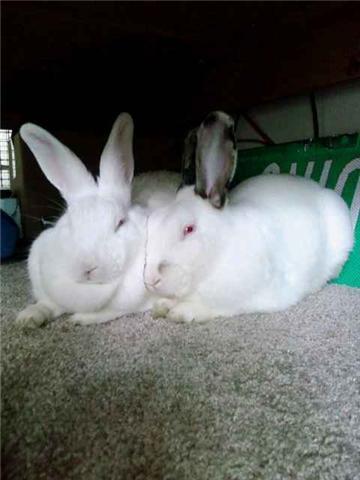 Weening off baby rabbits
QuestionWalle and Eva
QUESTION: I have a male ra
Weening off baby rabbits
QuestionWalle and Eva
QUESTION: I have a male ra
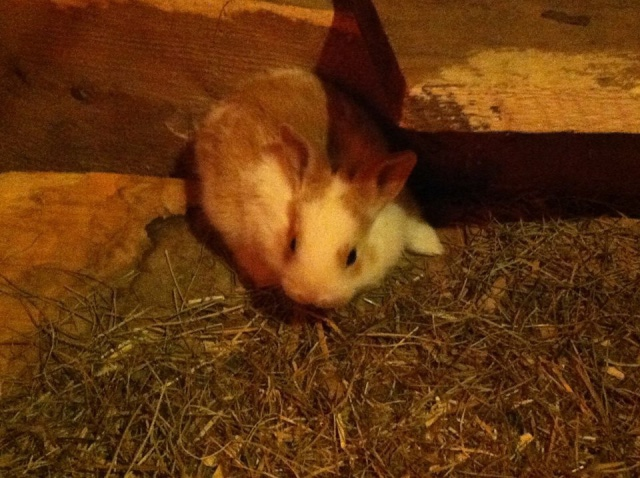 Help!! Can a Rex rabbit survive a Vermont winter?
Question
Rex rabbit (baby) Rex rabbit #2 (baby) &
Help!! Can a Rex rabbit survive a Vermont winter?
Question
Rex rabbit (baby) Rex rabbit #2 (baby) &
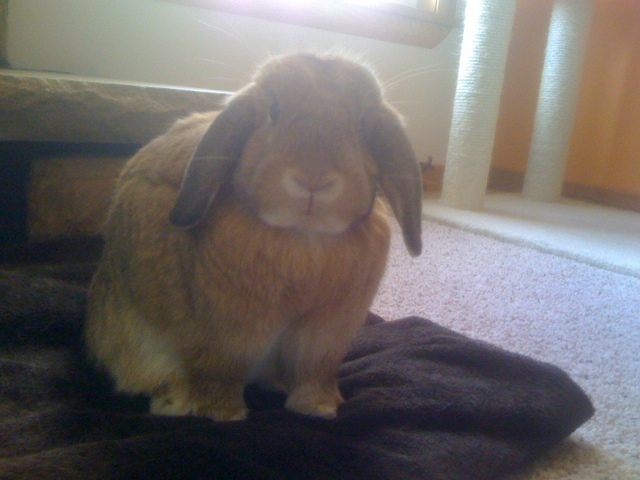 Holland Lop destroying house
Question
Horror
Hi, I have a female Holland Lop who is
Holland Lop destroying house
Question
Horror
Hi, I have a female Holland Lop who is
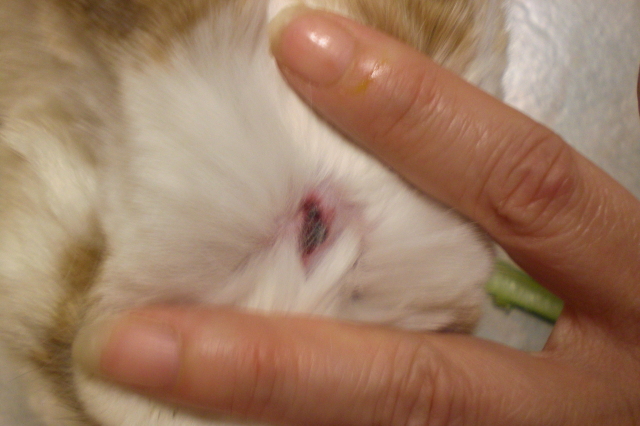 Rabbit acting different?
QuestionQUESTION: Hi, I recently found out that my rabb
Rabbit acting different?
QuestionQUESTION: Hi, I recently found out that my rabb
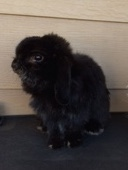 Rabbit with Head Tilt Dies
Question
Ebony
We adopted a stray lop bunny five
Rabbit with Head Tilt Dies
Question
Ebony
We adopted a stray lop bunny five